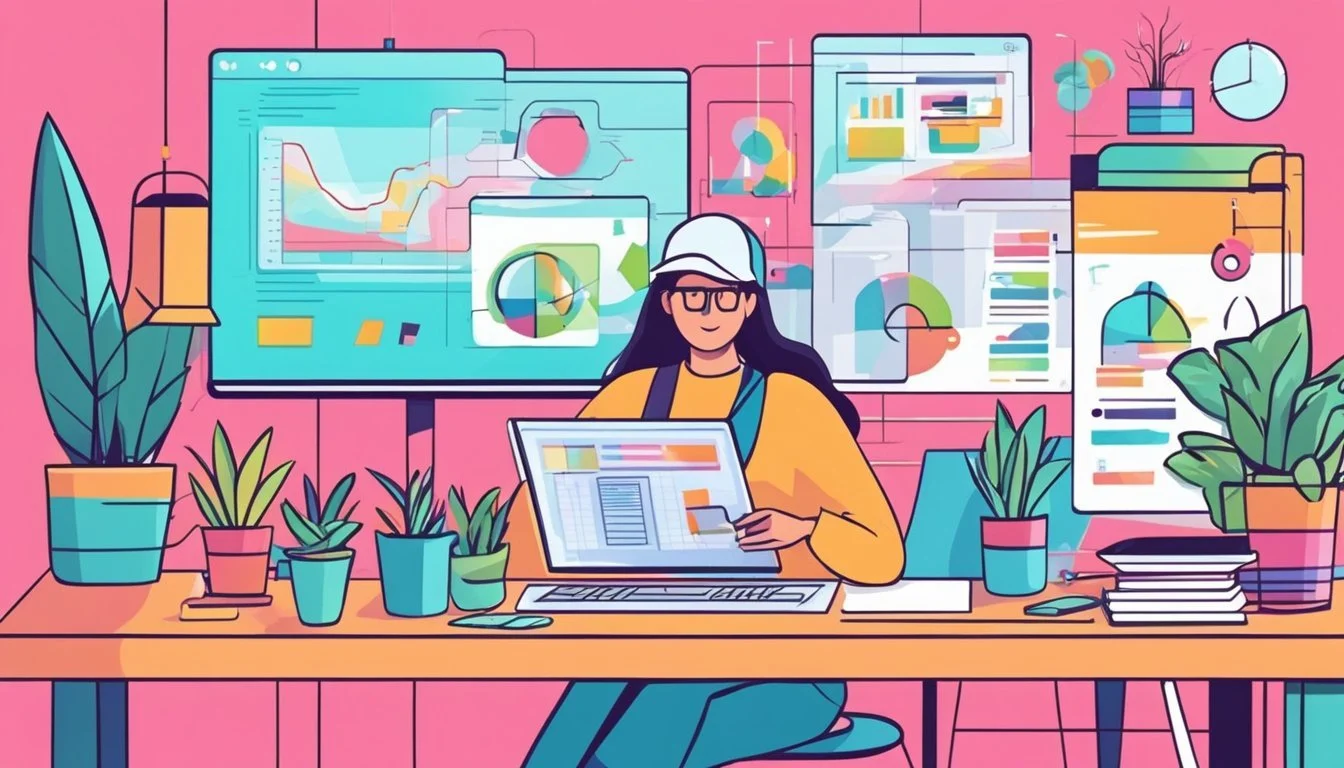14 Traits of Highly Innovative Thinkers
Unlocking Creative Potential
Innovation drives progress in every industry, and understanding what makes thinkers thrive can significantly impact personal and professional development. Recognizing these traits can help individuals foster creativity, improve problem-solving skills, and contribute to meaningful advancements in their fields.
This article explores the key characteristics that distinguish highly innovative thinkers. By examining these traits, readers can gain insights into habits and mindsets that encourage innovation, enabling them to unlock their own creative potential.
1) Embracing Failures as Learning Opportunities
Innovative thinkers view failures as stepping stones rather than setbacks. This mindset allows them to gather valuable insights from each failed attempt, ultimately guiding them closer to success. By embracing failure, they cultivate resilience and adaptability.
Encouraging a culture of experimentation is essential. Leaders should motivate their teams to take calculated risks and explore new ideas, even if they might not succeed at first. This approach fosters creativity and continuous improvement.
Analyzing failures helps identify areas for growth. Innovators who regularly assess the reasons behind their failures are better equipped to make informed decisions in the future. This process is a crucial part of the learning cycle.
Organizations can benefit significantly from understanding that different types of failures exist. By distinguishing between avoidable and unavoidable failures, they can create environments that promote learning and innovation. Embracing this perspective keeps them ahead of the competition.
2) Cultivating curiosity and asking questions
Cultivating curiosity is a fundamental trait of innovative thinkers. They maintain an insatiable interest in the world around them, never taking things at face value and constantly seeking to understand more deeply.
Asking questions is a critical method for fostering this curiosity. Innovative thinkers frequently challenge assumptions, probe for new insights, and strive to uncover hidden patterns or connections. This habit of questioning helps them explore diverse perspectives and solutions.
Curious individuals are not afraid to explore uncharted territories. They often seek new experiences, whether through learning new skills, traveling, or engaging with diverse groups of people. This breadth of experience enriches their thinking and fuels creativity.
Organizations can encourage curiosity by creating environments that value knowledge exploration and question-driven discussions. Leaders can inspire their teams by encouraging open-ended questions and supporting continuous learning.
Implementing a culture of curiosity within a team can drive collective innovation. When everyone is encouraged to ask questions and explore new ideas, it leads to more collaborative and inventive solutions. The practice of continuously questioning and exploring becomes a catalyst for innovation and success.
For more insights into how cultivating curiosity drives innovation, check out this article on How Asking Questions Drives Innovation and Success.
3) Practicing Mindfulness and Self-Reflection
Practicing mindfulness and self-reflection is crucial for innovative thinkers. Engaging in mindful self-reflection helps individuals develop greater self-awareness. This, in turn, leads to personal growth and enhanced emotional intelligence.
Mindfulness has roots in long-standing Eastern spiritual traditions, particularly Buddhist philosophy. It encourages being present in the moment and fostering a connection to a broader sense of oneness.
Through mindful practices, individuals can identify and challenge limiting beliefs. This process fosters a more balanced and resilient mindset.
Taking time for reflection allows creative thinkers to let go of overreliance on a sense of individualized identity. This enables them to connect with their creativity on a deeper level.
For example, regular meditation can help calm the mind and offer opportunities to create and innovate. Incorporating mindfulness into daily routines can significantly impact an individual's creative capabilities.
Self-reflection does not mean dwelling on the past but rather understanding one's thoughts and behaviors. This approach helps innovative thinkers refine their problem-solving skills and adapt to new situations effectively.
By practicing mindfulness and self-reflection, highly innovative thinkers maintain a heightened level of clarity and focus. This practice nurtures their ability to generate novel ideas and solutions.
In summary, mindfulness and self-reflection play a crucial role in fostering the innovative capabilities of creative individuals. They enable a deeper connection with one’s inner creative potential and contribute to overall personal and professional growth.
4) Building Diverse and Inclusive Teams
Diverse and inclusive teams are pivotal in fostering innovation. These teams combine different perspectives, experiences, and skills, leading to more creative and effective problem-solving.
Leaders should strive to create environments where all members feel valued and heard. This inclusivity encourages unique contributions and ensures that every voice can influence decisions.
Recruiting individuals from various backgrounds is essential. Companies often benefit from hiring beyond their usual criteria, thus expanding their talent pool and bringing in fresh ideas.
Retention requires ongoing support and engagement. Regular team-building exercises can improve communication and strengthen relationships within the group.
By focusing on building diverse and inclusive teams, companies not only enhance their innovation potential but also create a more dynamic and supportive workplace. Research from Harvard Business Review supports the effectiveness of these strategies in achieving business success.
5) Seeking Inspiration from Different Fields
Innovative thinkers often draw inspiration from a variety of sources. By exposing themselves to different fields, they can integrate unique perspectives that fuel creativity.
They may explore disciplines like art, science, and technology. This cross-pollination of ideas helps break down conventional barriers and promotes novel solutions.
Visiting museums, attending conferences, and reading diverse literature are common practices. These experiences enrich their knowledge and stimulate fresh ideas.
Collaborating with professionals from various industries also fosters innovation. Diverse teams bring a range of viewpoints that can lead to breakthroughs.
This approach helps them stay ahead of trends. By looking beyond their immediate industry, they can anticipate shifts and adapt more effectively.
6) Maintaining a Growth Mindset
Maintaining a growth mindset is crucial for innovation. It involves the belief that abilities and intelligence can be developed through effort, learning, and perseverance. This mindset encourages taking on challenges and viewing failures as opportunities to grow.
Individuals with a growth mindset are more likely to embrace continuous learning. They seek out new skills and knowledge, keeping themselves adaptable in dynamic environments. This attitude aligns with fostering creativity and innovation.
Organizations benefit when they cultivate a growth mindset. They can recognize and overcome social and organizational pressures that inhibit creativity. Rewarding experimentation and learning from mistakes can lead to significant breakthroughs.
Adopting a growth mindset also involves unfixing trapped mindsets. Encouraging flexibility and open-mindedness allows for a more innovative and responsive approach to problem-solving. Individuals can develop their abilities by leveraging effort and determination.
Emphasizing a growth mindset in teams promotes collaboration and idea-sharing. When team members believe in development, they support each other, contributing to a culture of collective innovation. This creates a synergy that can drive more effective and creative outcomes.
For more detailed insights on how to cultivate a growth mindset, visit the RSM Global article.
7) Experimenting with new ideas regularly
Innovative thinkers embrace the practice of regularly experimenting with new ideas. They aren't afraid to test concepts, even if they seem unconventional. Experimentation allows them to explore possibilities that others might overlook.
By consistently engaging in trial and error, they can identify what works and what doesn't. This approach helps them refine their strategies and improve their solutions. Innovation often arises from these repeated attempts.
Regular experimentation fosters a culture of curiosity and resilience. When creative individuals experiment frequently, they become more adaptable to changes. They gain insights that can lead to breakthrough innovations.
For instance, a key aspect of creative thinking is the ability to try new things in various settings. This could range from a personal practice to a professional environment. Engaging in different experiments can help mitigate the risks of critical judgment or overthinking, often barriers to creativity.
Exploring multiple approaches increases the chances of discovering novel solutions. Innovative thinkers understand that not every experiment will succeed, but each one provides valuable learning. This iterative process is crucial for sustained creativity and innovation.
8) Prioritizing Time for Creative Thinking
Highly innovative thinkers recognize the importance of dedicating specific time blocks for creative thought. They understand that creativity doesn't just happen spontaneously but often requires intentional effort and environment.
By setting aside uninterrupted time, individuals can immerse themselves in their creative processes without constant distractions. This could be a quiet hour in the morning or a reserved afternoon period free from meetings and interruptions.
Innovative thinkers also see the value in regularly scheduling "thinking breaks." These breaks allow the mind to wander and explore new ideas, contributing to a more fertile ground for creative solutions.
Another practice is to incorporate creative activities into daily routines. Activities such as brainstorming sessions, mind mapping, or even engaging in hobbies that stimulate creative thought can be beneficial.
Moreover, being mindful of when they are most productive and aligning creative tasks with those peak times can enhance innovation. For some, this might be early morning, while for others, late at night.
Creating a conducive environment is equally important. This can involve having a designated workspace that inspires creative thinking, free from clutter and equipped with tools that encourage ideation.
These approaches show that prioritizing time for creative thinking is fundamental for fostering innovation.
9) Collaborating and Sharing Knowledge
Innovative thinkers understand the power of collaboration. Working with diverse teams brings new perspectives and ideas, which can spark creativity. This diversity is essential for tackling complex problems that require out-of-the-box solutions.
They also recognize the importance of sharing knowledge. By fostering an open environment where information flows freely, they encourage continual learning and innovation. Sharing insights helps teams build on each other's ideas, leading to breakthroughs.
Effective collaboration requires more than just working together. It involves establishing trust, a shared vision, and commitment to collective success. Leaders play a crucial role in cultivating a collaborative ecosystem that supports innovative thinking.
Innovation thrives when ideas and knowledge are shared openly. Knowledge sharing can be a key driver for innovation, making it a top priority for industry leaders. Employees who share innovative knowledge tend to excel and contribute significantly to organizational growth.
In today's competitive environment, the ability to collaborate and share knowledge effectively sets innovative thinkers apart. This skill is essential for driving change, adopting new technologies, and staying ahead in the market. By embracing these principles, they create a culture that nurtures innovation and continuous improvement.
10) Focusing on Customer Needs and Feedback
Innovative thinkers excel when they prioritize understanding and addressing customer needs. By continually gathering insights from customers, they can identify gaps and opportunities in the market. This focus enables them to create products and services that truly resonate with their audience.
They often employ a variety of methods to collect feedback, such as direct customer interviews, surveys, and digital tools. Utilizing customer journey mapping helps them understand how consumers interact with their offerings and identify pain points.
Analyzing this feedback and data allows innovators to make informed decisions. They can iterate on their ideas and solutions to better meet customer expectations. Companies like Apple and Amazon are well-known for their customer-centric approaches.
Incorporating feedback into product development processes ensures that the final output is tailored to real user needs. This not only enhances customer satisfaction but also drives loyalty and long-term success. Emphasizing a customer-focused culture within the organization amplifies these benefits.
Innovative thinkers realize that customer needs and feedback are not static; they evolve over time. Regularly revisiting and updating their understanding keeps them aligned with shifting market demands. This dynamic approach helps maintain relevance and competitiveness in the industry.
11) Learning from historical examples
Learning from historical examples can offer valuable insights into innovative thinking. Figures like Leonardo da Vinci exemplify unparalleled creativity. His diverse talents as an inventor, painter, and engineer showcase a broad thinking approach. Da Vinci’s sketches and scientific diagrams illustrate foresight in areas like flight and mechanical engineering (Think Creative).
Another shining example is Steve Jobs. His ability to blend technology and art revolutionized multiple industries. Jobs employed five discovery skills that set him apart from ordinary managers. These skills include observing, questioning, networking, experimenting, and associating (HBSWK).
Historical thinkers often break free from societal and ideological constraints. Their unique perspectives allow them to make groundbreaking discoveries. This independent mindset is crucial for fostering innovation (The Dream Catch).
Understanding how past minds used curiosity and imagination can inspire current and future innovators. By studying their methods, creative individuals can gain the tools needed to push boundaries. For example, history’s best thinkers utilized both the default mode network and the executive control network to produce useful, creative ideas (The Bioneer).
12) Setting Ambitious but Achievable Goals
Innovative thinkers understand the importance of setting ambitious yet achievable goals. This balance is crucial for maintaining motivation and ensuring progress.
When setting goals, they focus on challenging objectives that push the boundaries of what is possible. This challenges their abilities and encourages creative solutions.
Equally important is ensuring these goals are realistic. Ambitious goals need to be within reach to avoid discouragement.
Successful innovators often break down large goals into smaller, actionable steps. This approach makes the larger goal less daunting and provides a clear path to completion.
They also connect each goal to a meaningful purpose, understanding the "why" driving their efforts. This keeps them focused and committed.
In some cases, experienced innovators prefer flexibility in their goal-setting methods. For instance, they might move beyond the rigid SMART framework to embrace more fluid strategies.
By continually monitoring progress, they adjust their strategies as needed, ensuring that they stay on track.
Highly innovative thinkers keep their teams aligned with clear, shared goals. Regular check-ins help maintain momentum and adapt to any changes that arise.
Setting ambitious but achievable goals is a key trait that fuels innovation and drives sustained growth.
13) Being Adaptable and Open to Change
Highly innovative thinkers excel at adapting to new situations and challenges. They understand that change is inevitable and often brings new opportunities.
Adaptable individuals are not rigid in their thinking. They are willing to pivot their approaches when faced with new information or unexpected obstacles.
Being open to change allows innovative thinkers to embrace new ideas and perspectives. This openness fuels creativity and leads to the discovery of novel solutions.
Innovative minds appreciate the fluidity of life and business environments. They see change as a chance to improve and grow, rather than a disruption.
Flexible thinkers remain curious and continuously learn from their experiences. This ongoing learning helps them stay ahead in their fields and adapt strategies as needed. Embracing an innovative mindset is essential for maintaining relevance and competitiveness.
By remaining adaptable, they can respond quickly to emerging trends and technologies. This responsiveness is crucial for driving innovation and staying ahead of the curve. Viewing the world from a different perspective enhances their ability to innovate.
Acceptance of change also helps build resilience. When faced with setbacks, adaptable thinkers can adjust their plans and keep moving forward. This resilience is a key characteristic of successful innovators.
14) Utilizing Technology to Enhance Creativity
Innovative thinkers often harness technology to boost their creativity. Digital tools like graphic design software and video editing programs enable them to create visually appealing content quickly and efficiently.
They use collaboration platforms to brainstorm and develop ideas with team members, regardless of geographical location. This fosters a diverse range of perspectives, enriching the creative process.
Artificial Intelligence (AI) plays a significant role as well. AI-driven applications can generate suggestions, improve designs, and automate repetitive tasks. This allows creative minds to focus on more complex and innovative aspects of their projects.
Moreover, social media and other online platforms provide a vast array of inspiration and resources. They can explore different cultures, trends, and ideas, which can spark new concepts and creative approaches.
Cloud storage solutions ensure that their work is easily accessible and securely stored. This accessibility encourages experimentation and iteration, essential components of the creative process.
Using technology, they can also engage in virtual reality (VR) and augmented reality (AR) experiences. These cutting-edge tools let them visualize abstract ideas and create immersive presentations that captivate their audiences.
The integration of technology in their workflow not only boosts productivity but also enhances their ability to generate, refine, and implement creative ideas. By leveraging these technological advancements, innovative thinkers continuously push the boundaries of creativity.
Understanding the Essence of Innovative Thinking
Innovative thinking is the ability to approach challenges and opportunities with a fresh perspective, leading to creative solutions and groundbreaking ideas. This section delves into defining what innovation truly means and why it is essential.
Defining Innovation
Innovation refers to creating new ideas, methods, or products that significantly improve or transform existing systems. It involves thinking outside conventional boundaries to develop solutions that are not only creative but also practical.
Key elements of innovation include:
Creativity: The capability to generate novel ideas.
Implementation: Turning those ideas into tangible outcomes.
Value Creation: Producing solutions that offer meaningful benefits.
For instance, Isaac Asimov's innovative thoughts in science fiction have influenced real-world advancements in robotics and artificial intelligence, showing how creative ideas can lead to significant technological progress.
Importance of Innovative Thinking
Innovative thinking is crucial for staying competitive in today's fast-paced world. It enables businesses and individuals to adapt to changing environments and seize emerging opportunities.
Benefits include:
Competitive Advantage: Companies that innovate tend to dominate their industries.
Problem-Solving: Creative solutions offer new ways to tackle persistent challenges.
Economic Growth: Innovation drives job creation and boosts economic activity.
By cultivating skills like questioning, observing, and experimenting as suggested by visionaries, individuals can enhance their innovative thinking abilities. Innovative thinking not only leads to personal growth but also fuels societal advancements.
Cultivating a Creative Mindset
Cultivating a creative mindset involves encouraging curiosity and skillfully balancing imaginative ideas with practical realities. This allows innovative thinkers to explore new concepts and transform them into tangible results.
Embracing Curiosity
A key trait of innovative thinkers is their innate curiosity. They consistently ask questions and seek out new knowledge to fuel their creative processes. Embracing curiosity means welcoming uncertainty and being eager to explore the unknown.
Curious individuals actively seek diverse experiences and perspectives. This broadens their understanding and provides inspiration. Reading widely, both within and outside their fields of expertise, can introduce new ideas and solutions.
They maintain an open mind, ready to entertain unconventional ideas without immediate judgment. This encourages a culture of experimentation and learning, essential for innovation. By fostering a habit of continuous learning and exploration, individuals can stimulate their creativity effectively.
Balancing Imagination and Reality
Innovative thinkers excel in blending imaginative ideas with practical implementation. While imagination allows for the generation of novel concepts, grounding these ideas in reality is crucial for their successful application.
Balancing imagination and reality requires critical thinking and realistic assessment of ideas' feasibility. They visualize potential outcomes and refine their ideas to align with practical constraints and opportunities.
Creativity thrives in environments that promote both free thinking and rigorous testing. Engaging with both visionary and pragmatic aspects enables innovative thinkers to transform abstract concepts into actionable plans. This balance ensures that creative ideas are not only original but also achievable, leading to meaningful and impactful innovation.
Using techniques like mind mapping and SWOT analysis helps evaluate ideas from multiple perspectives. This structured approach supports imaginative exploration while ensuring practicality and relevance in real-world scenarios.











